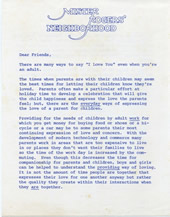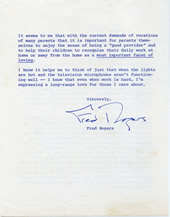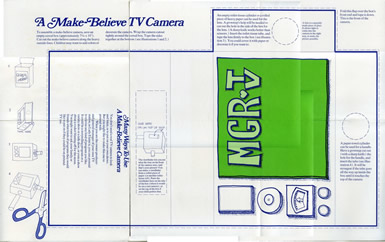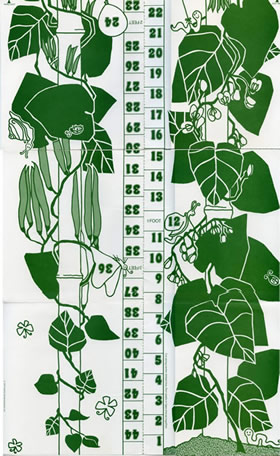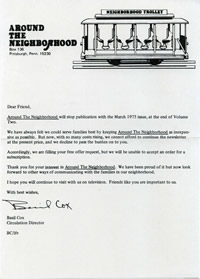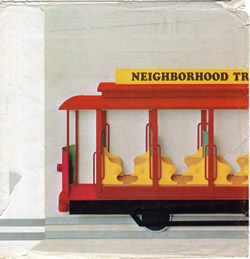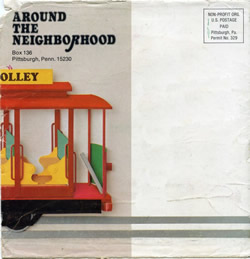Around the Neighborhood - Volume 2, Number 9
This issue of Around the Neighborhood was published in February of 1975.
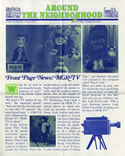
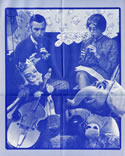

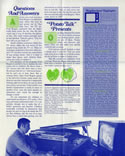
[click images for larger view]
Articles Included:
- Front Page News! MGR-TV
- Sounds and Music
- Sounds You Can Make
- Rhythms
- Questions and Answers
- "Potato Talk" Presents
- Neighborhood Highlights
A Message From Fred Rogers
Along with this issue of Around the Neighborhood came a letter from Fred Rogers...
Dear Friends,
There are many ways to say "I Love You" even when you're an adult.
The times when parents are with their children may seem the best times for letting their children know they're loved. Parents often make a particular effort at holiday time to develop a celebration that will give the child happiness and express the love the parents feel; but, there are the everyday ways of expressing the love of a parent for children.
Providing for the needs of children by adult work for which you get money for buying food or shoes or a bicycle or a car may be to some parents their most continuing expression of love and concern. With the development of modern technology and commerce many parents work in areas that are too expensive to live in or places they don't want their families to live so the time of the work day is increased by the commuting. Even though this decreases the time for companionship for parents and children, boys and girls can be helped to understand the providing way of loving. It is not the amount of time people are together that expresses their love for one another anyway but rather the quality they create within their interactions when they are together.
It seems to me that with the current demands of vocations of many parents that it is important for parents themselves to enjoy the sense of being a "good provider" and to help their children to recognize their daily work at home or away from the home as a most important facet of loving.
I know it helps me to think of just that when the lights are hot and the television microphones aren't functioning well -- I know that even when work is hard, I'm expressing a long-range love for those I care about.
Sincerely,
Fred Rogers
Articles
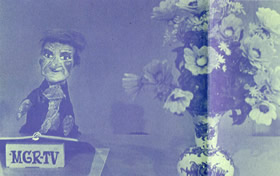 "What do we need in this beautiful neighborhood of ours?" Lady Elaine asked herself one day.
"What do we need in this beautiful neighborhood of ours?" Lady Elaine asked herself one day.
"We need a TV station of our own," she answered herself. "And who has the vim and vigor to start that TV station?" she asked herself next. "-- I DO! I'll call it Museum-Go-Round TV. MGR-TV for short."
So Lady Elaine asked Pilot Yoshi Ito to fly special television equipment to Make-Believe. First Lady Elaine needed a camera to photograph her shows. Next she needed lights to make the studio bright enough for the camera to work. And she needed a microphone, too, so the sounds of each 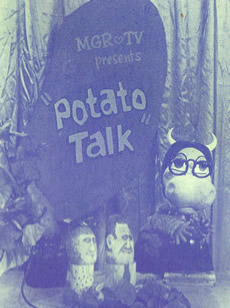 program could be heard on TV. Handyman Negri built a remote camera on wheels that could go anywhere to televise things. Lady Aberlin and other neighbors would take turns televising interesting things outside the studio. Bob Dog planned to do a dance on television. X the Owl wanted to show what he knew about flying. Chef Brockett and Edgar Cooke would present "Cooking Tips," and Harriett Elizabeth Cow planned to do a program called "Potato Talk."
program could be heard on TV. Handyman Negri built a remote camera on wheels that could go anywhere to televise things. Lady Aberlin and other neighbors would take turns televising interesting things outside the studio. Bob Dog planned to do a dance on television. X the Owl wanted to show what he knew about flying. Chef Brockett and Edgar Cooke would present "Cooking Tips," and Harriett Elizabeth Cow planned to do a program called "Potato Talk."
When you make up your own TV station the way Lady Elailne did, you can have as many different programs as you like. And you can say whatever you like. Lady Elaine said, "This is your charming hostess, Lady Elaine Fairchilde, bringing you the best of MGR-TV!"
Even before you know how to talk, you can make many different kinds of sounds. When you were a baby you played with sounds. As you grew, you learn words. The sound and meaning of your words lets you tell people what you see, what's inside you, what you want, and many other things.
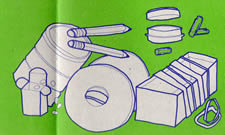 Your voice comes from a place inside your throat called a voice box, or larynx. Inside the voice box there are vocal cords that are shaped like strings. Whenever you make a sound, your vocal cords vibrate. That makes the sound from inside you that people can hear, your voice.
Your voice comes from a place inside your throat called a voice box, or larynx. Inside the voice box there are vocal cords that are shaped like strings. Whenever you make a sound, your vocal cords vibrate. That makes the sound from inside you that people can hear, your voice.
Put your hand on your throat and say your name out loud. Your fingers can feel your throat vibrate -- the vibration is the tingling buzz you feel. That buzz is your voice forming a sound.
Your voice can make many sounds besides words. You can use it to hum or harumph. You can shout, sing a song, bark like a dog or beep like a horn if you feel like it.
Musical instruments can make many different sounds too.
King Friday's bass has strings made of fine wire. The King plucks the strings or plays them with a bow. The strings vibrate (something like the way your vocal cords do) to make the sound.
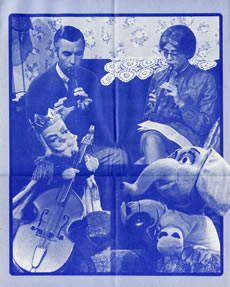 Mrs. McFeely's recorder is made of wood. It's hollow inside. To make a sound with it, Mrs. McFeely blows into it. Her breath pushes air down inside the recorder and out the small holes in the sides. The air blowing through the recorder and out the holes vibrates to make a sound. In the picture, Mrs. McFeely and Mister Rogers are playing recorders.
Mrs. McFeely's recorder is made of wood. It's hollow inside. To make a sound with it, Mrs. McFeely blows into it. Her breath pushes air down inside the recorder and out the small holes in the sides. The air blowing through the recorder and out the holes vibrates to make a sound. In the picture, Mrs. McFeely and Mister Rogers are playing recorders.
H.J. Elephant III has a pair of cymbals. They are made of metal. To make a sound with them, H.J. clangs the two cymbals together. The metal vibrates and rings out a sound.
You can make a rhythm drum from an empty coffee can with a plastic lid. Tap it with your hand, tape it with your fingertips. Tap it on the metal end. Tap it on the plastic end. Tap along with sounds and songs from TVs and radios. Tap with a spoon! Hear the difference?
To make a set of cymbals, borrow two pan lids from a grownup. (Be sure to get the grownup's OK -- for the lids and for the music!) Bang the lids together. They make a bright, loud, ringing, clanging clash.
Take a handful of rice or dried beans or popcorn kernels. Put them in a small empty box or can, or an empty shoe polish tin. Close them up. Shake the tins and boxes loud and soft. Put two or three paperclips inside one container. Shake them up. Count 1-2-3...1-2-3...Count 1-2 1-2 1-2.
To make some string-instrument sounds, take the bottom half of a shoebox. Stretch four rubber bands around the box. Try to use some fat rubber bands and some skinny ones. Pluck each string with your fingers. Pull one string tighter and pluck it. The sound gets higher the tighter you pull the string.
Natural movements make rhythms you can clap to. You could pound a drum to them too or bang a cymbal for them. The tick of a clock, the left-right-one-two of your walk, the bounce of your feel when you skip, rocking back and forth in a chair or pumping a swing in the park -- all are actions that have rhythm. You can clap in time to themif you want to hear a rhythm. Mister Rogers likes to pick out the rhythms in things. He made up a rhythm one day when he was thinking about the opera, Potato Bugs and Cows. It went like this: potato, potato, sweet-potato-sweet.
A child who had watched Fred Rogers on television once asked him how he had gotten out of “that little box,” the TV set. Fred Rogers explained that he hadn’t really been inside the set, that the television was a way of showing the picture of him. The child waited patiently until he had finished. Then he asks, “Yes, but how will you get back in?”
Small children sometimes think that TV shows reflect the real antics of tiny people living inside a TV set. They are sometimes surprised to find the other people’s TV sets at exactly the same bunch of tiny people inside. It is hard to shake the theory until children themselves are ready to replace it.
For instance, on the program, Fred Rogers is careful to try to explain his television role to children. He shows them a TV camera and tells them what it does. He stresses that he is a “television friend,” but he can’t see or hear them. But in closeup shots, when Fred Rogers speaks to his television friends, many small children are sure that, because he is apparently looking right out at them, he can see them just as they can see him. Until a child’s own mental organization is ready to move to another level, even the most careful explanations can’t reach far enough to change in mind.
It’s not important for children to understand exactly how a TV works. (Not many grownups understand that!) It is important, though, not to make fun of a child’s questions and theories. Children eventually concluded by themselves that people are just too big to fit inside the TV set. But children, like the rest of us, may always have a hard time getting over the amazement we feel at meeting a television face in real life. And we may never outgrow our urge to ask, like the five-year-old who was introduced to Fred Rogers, “How come you’re so tall?”
One thing Harriett Elizabeth Cow liked about potatoes was making potato printers out of them. Potato prints can decorate gift paper. They can also make very special cards for any occasion.
Cut a potato in half. Scratch or dent a design on it if you like. You can print right away if you want to; or let the potato dry for an hour to make a clearer print.
Dip the potato into undiluted food coloring. Press the potato onto paper and hold there a moment. (A carrot or onion can make a good printer, too.)
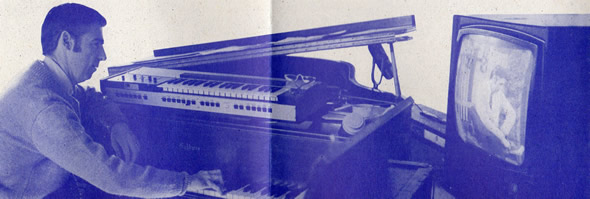
Note: If you miss a program that you or your child is particularly interested in, check with your local station to see when it will be repeated. Give them the program number.
Week of February 3:
Mr. McFeely is proud of the new player piano he has bough (#511). In Make-Believe, Lady Elaine things that she and Corny [sic] are getting married. In #512, Mister Rogers shows a floor plan for a house. In #513, Mister Rogers explains that television is like a picture or a movie -- you can't touch or smell or hold what you see, but you can think about it. Mister Rogers shows a film of himself and puppeteer Bill Barker operating the puppets of Make-Believe in #514. Lady Elaine inaugurates her own TV station, MGR-TV. In #515, Chef Brockett has a 35¢ Banana Split Special. He shows Mister Rogers how to make splits. King Friday demands that Lady Elaine have a license for her station.
Week of February 10:
Bob Trow demonstrates silkscreen printing (#516) and Mister Rogers shows a film about kindergarten. In #517, Joe Negri demonstrates TV equipment, including a camera and a microphone. Chrissy and Terri Thompson make a puppet stage from a refrigerator carton. In Make-Believe, a witch costume frightens Henrietta Pussycat. Mister Rogers makes a simple icebox cake. Chrissy and Terry [sic] present their puppet show, The Princess and the Pea.
Week of February 17:
In #521, Audrey-Cleans-Everything shows Mister Rogers her new mobile home and office. Daniel Striped Tiger takes tap-dancing lessons in #522. On Wednesday, in #523, Hector Olivera demonstrates an organ. In #524, Barbara Boomerang Frisbee's giant frisbee turns into a tap-dancing stage and all the neighbors dance on it. In #525, Henrietta Pussycat plans to give some hand-me-downs to little Ana, and X learns that trying on someone else's clothes doesn't mean you become that person.
Week of February 24:
Prince Tuesday gets lost (#526) but Lady Elaine's announcement on MGR-TV quickly gets him found. In #527, Mister Rogers shows a film about children pretending, and Lady Elaine makes some toy blocks look like they're dancing. Mister Rogers experiments with magnets in #528, and plays a game of horseshoes with Bob Trow. In #529, Mister Rogers shows an autoharp, and visits a concert harpist performing at the bakery. Rita Moreno Gordon and her family visit and talk about the work each family member does. In #530, Mister Rogers reads the "Speedy Delivery" book and talks about libraries.
Issue Extras
Included in this issue of Around the Neighborhood were instructions for making a Make-Believe TV Camera...
...and a growth chart to document a child's height.
Notes
A letter from Circulation Director, Basil Cox, was sent with this issue of Around the Neighborhood informing readers that there would only be one more issue of the newsletter.
Dear Friend,
Around the Neighborhood will stop publication with the March 1975 issue, at the end of Volume Two.
We have always felt we could serve families best by keeping Around the Neighborhood as inexpensive as possible. But now, with so many costs rising, we cannot afford to continue the newsletter at the present price, and we decline to pass the burden on to you.
Accordingly, we are filling your free offer request, but we will be unable to accept an order for a subscription.
Thank you for your interest in Around the Neighborhood. We have always been proud of it but now look forward to other ways of communicating with the families in our neighborhood.
I hope you will continue to visit with us on television. Friends like you are important to us.
With best wishes,
Basil Cox
Circulation Director
All contents were shipped in a square envelope showing the image of the Neighborhood Trolley.
Credits
Around the Neighborhood and the materials that accompany it are published ten times a year by Family Communications, Inc., a not-for-profit Pennsylvania corporation. Mister Rogers' Neighborhood is funded by public television stations, the Ford Foundation, the Corporation for Public Broadcasting, Sears Roebuck Foundation, and Johnson & Johnson Baby Products Company.
Around the Neighborhood is created in association with Media Projects Incorporated of New York. Subscriptions, printing, and distribution are accomplished by Multiscope, Inc., Pittsburgh, Pa.
Executive Editor: Sara Stein
Editor: Barbara Staib
Editorial Consultant: Hedda Sharapan
Psychological Consultant: Dr. Margaret McFarland
Graphic Designer: Abe Echevarria
© 1975, Family Communications Inc.

